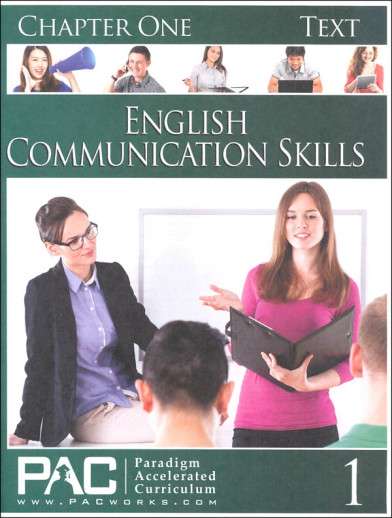We use cookies to make your experience better. To comply with the new e-Privacy directive, we need to ask for your consent to set the cookies. Learn more.
English Communication Skills: Chapter 1 Text
In English Communication Skills students learn how to construct sentences, paragraphs, essays, letters, and other forms of communication. Each lesson includes a vignette of a positive role model to illustrate how values, beliefs, and character affect communication skills and life choices. QR-codes, charts, photos, and illustrations are strategically placed to enhance comprehension. Every lesson includes a life principle selected to appeal to conscience to enable students to make wise choices. Selected vocabulary words are bolded and defined to help enrich the students' understanding of the English language If English Communication Skills is completed as a high school course, it is worth one transcript credit. The course is excellent for high school students or adults with academic gaps or a limited understanding of the English language. Proctors/teachers can assign students to complete the chapter tests of English Communication Skills, English Grammar Skills, and English I: Language Skills to identify English learning gaps that need to be filled before a student graduates. High school students may earn one transcript credit by completing at least six chapters of "gaps composed of various Paradigm English chapters.
English Communication Skills is a comprehensive course designed for application in grade 7, but is applicable for grades 7 through 12 to address academic gaps in the English. The course consists of five chapters bound in soft-cover texts with five companion student activity books that "walk students chronologically through components of the English language. Seventy-five lessons,15 quizzes, and five chapter tests cover the basics components of oral and written communication in the English language.
This course covers parts of speech, origins of common English words, basic sentence structure, parts of a sentence, phrases, clauses, commonly misused words, prefixes, suffixes, figures of speech, homonyms, homophones, homographs, synonyms, antonyms, typing keyboards, punctuation, literary genres, history of writing, cursive writing, handwriting, informal letter writing, formal letter writing, compare/contrast, note-taking, powerpoint presentations, sentences, paragraphs, essay construction, writing process, listening skills, speech, and critical thinking skills.
Available for this course: Full Course Kit (includes print Chapter Texts, Activity Books, and Teacher Resource Kit as well as a free digital download of the TRK). The Chapter Texts, Activity Books and Teacher Resource Kit can also be purchased separately.
| Product Format: | Paperback |
|---|---|
| Grade: | 7 |
| Brand: | Paradigm Accelerated Curriculum |
| ISBN: | 9781594761003 |
| Length in Inches: | 10.875 |
| Width in Inches: | 8.375 |
| Height in Inches: | 0.125 |
| Weight in Pounds: | 0.3 |
Be the first to review this item

